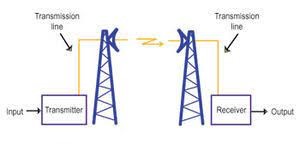Microwave Repeater
Line of Sight Communications by direct wave is characteristic of most of the radio frequency signals with frequency of above 30 MHz approx. This is true for VHF, UHF and microwave frequencies. These signals will pass through ionosphere and will not bend. Transmission distances at these frequencies are very much limited. Moreover, antenna height matters a lot to extend the distance coverage. Because of this reason, very high transmission antennas are used for FM and TV broadcasts.
As mentioned, one way to increase the range of transmission and reception at high frequencies is to place the antenna on top of the tall buildings or on mountains. The other way is to use repeater in between transmitter and receiver.
Microwave on-frequency RF repeaters are commonly used by telecommunications system operators to reliably and cost-effectively relay radio signals at remote locations, typically mountaintops and when bypassing obstructed paths. Understanding the use of microwave on-frequency repeaters requires an understanding of some basic operating concepts and how to apply the latest techniques.
A whole string of repeater stations can relay signals for larger distances. Typically, such relay stations are located at 20 to 60 miles apart. They are placed at high altitude to achieve reliable communication over long distances.
Organizations that use microwave repeaters include telephone companies, wireless operators, energy companies (water, gas, electric), government agencies (including national, state, county, and local agencies), military, aviation, and national security organizations. Such users expect reliable operation; areas of prime concern include path reliability, repeater-equipment reliability, and power-equipment reliability.

Products
Quick Contact
Need Help?
Please feel free to contact us. We will get back to you with 1-2 business days.
